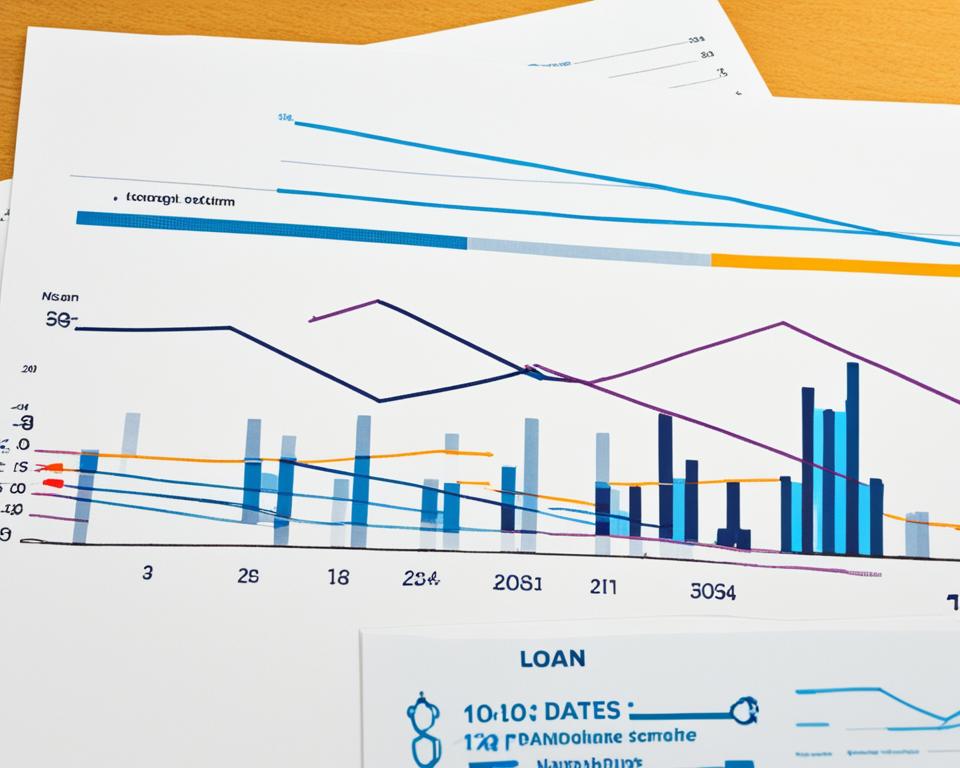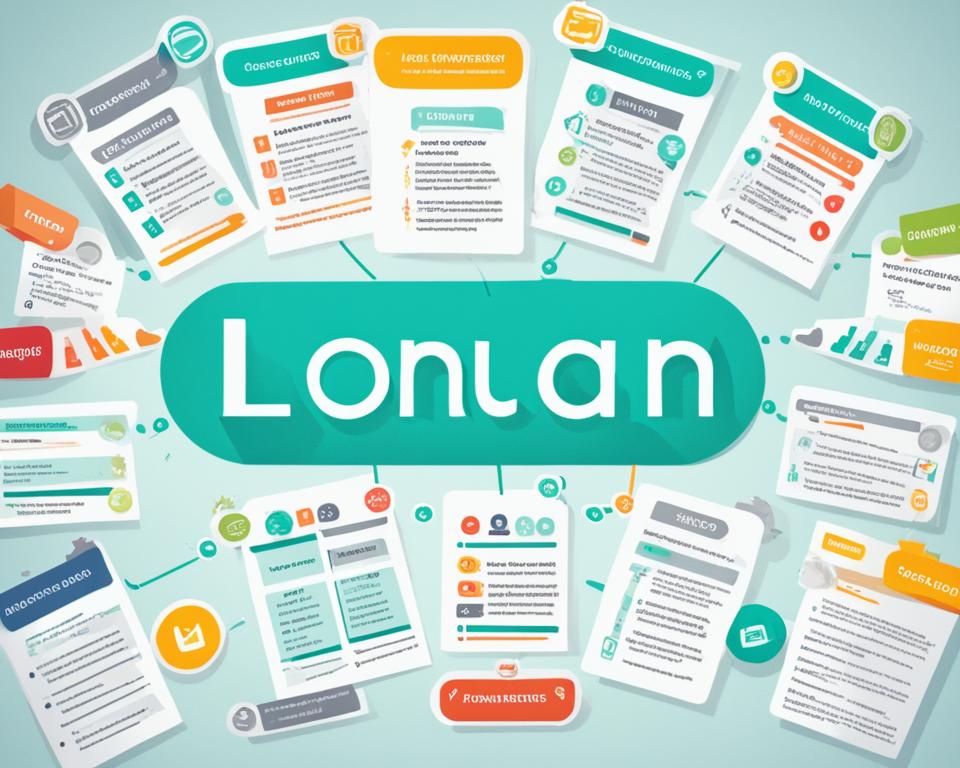As a beginner in the world of loans, it’s important to familiarize yourself with the common loan terms used in the industry. This loan terms glossary will provide you with a comprehensive understanding of terms like APR, amortization, and more, helping you navigate the loan process with confidence.
Key Takeaways:
- Loan terms are the conditions and details of borrowing money, including repayment period, interest rate, fees, and special conditions.
- Understanding loan terms is crucial for knowing your obligations as a borrower and making informed decisions.
- Loan terms can vary depending on the type of loan, so it’s essential to understand the specific terms applicable to your loan.
- Loan repayment period refers to the length of time you have to repay the loan and determines the duration of your payments and the total cost of the loan.
- Interest rate and fees are key components of loan terms that affect the cost of borrowing and the total loan amount.
What Are Loan Terms?
Loan terms are the set of conditions and agreements that govern the borrowing of money. When you take out a loan, whether it’s for a mortgage, car loan, or personal loan, you enter into a contract that outlines the terms and obligations associated with borrowing that money.
These loan terms include important details such as the repayment period, interest rate, fees, and any special conditions that may apply. The repayment period refers to the length of time you have to repay the loan. It can vary depending on the type of loan, ranging from a few months to several decades for a mortgage.
The interest rate is the percentage amount that the lender charges you for borrowing the money. It affects the total cost of the loan and determines how much you’ll pay in interest over the life of the loan. It is important to compare interest rates from different lenders to ensure you’re getting the best possible deal.
Fees are additional costs associated with the loan, such as origination fees, closing costs, or late payment fees. These fees can vary from lender to lender and can significantly impact the overall cost of borrowing.
Special conditions may also be included in the loan terms, such as penalties for early repayment or specific requirements for collateral. It’s crucial to carefully review and understand these conditions before signing the loan agreement to ensure you are fully aware of your rights and responsibilities as a borrower.
Understanding loan terms is essential for making informed decisions when it comes to borrowing money. It allows you to assess the affordability of the loan, compare different loan options, and negotiate more favorable terms with your lender.
Understanding Loan Terms
When it comes to borrowing money, lenders have specific conditions and guidelines that are outlined in the loan terms. These terms and conditions are crucial for both the lender and the borrower as they establish the framework for the loan agreement. Before signing any loan agreement, it is important to thoroughly review and understand the loan terms to avoid any surprises and ensure that you can fulfill your payment obligations.
Loan terms encompass a variety of elements, such as loan repayment period, interest rate, fees, and borrower responsibilities. By taking the time to understand these terms, you can make informed decisions and choose a loan that aligns with your financial goals.
Each loan agreement will have its own set of terms and conditions, so it is important to pay careful attention to the specific terms that apply to your loan. This includes understanding your repayment obligations, avoiding late payments, and knowing the consequences of defaulting on the loan.
“Understanding loan terms is crucial for ensuring that you are fully aware of your responsibilities as a borrower. Taking the time to review and comprehend the loan terms can save you from potential financial difficulties in the future.”
Here are some key aspects of loan terms that you should pay attention to:
- Loan Repayment Period: The loan repayment period refers to the duration of time in which you are expected to repay the loan. This can range from a few months to several years, depending on the type of loan. It is important to understand the length of the repayment period as it will determine the frequency and amount of your loan payments.
- Interest Rate: The interest rate is the cost of borrowing money and is expressed as a percentage. It is important to understand the interest rate associated with your loan as it will determine the total amount you will repay over the life of the loan. It is also important to consider whether the interest rate is fixed or variable, as this can have an impact on your monthly payments.
- Fees: Loan terms may include various fees such as origination fees, closing costs, or prepayment penalties. These fees can vary depending on the type of loan and the lender. It is important to carefully review the fee structure and understand the total cost of borrowing.
Understanding loan terms is essential for every borrower. By familiarizing yourself with the specific terms and conditions of your loan agreement, you can confidently manage your loan obligations and make informed financial decisions.
Types of Loan Terms
Familiarizing yourself with the different types of loan terms is crucial for making informed decisions when you borrow money. Loan terms can encompass various aspects of a loan, including the repayment period, interest rate, and fees. Understanding these terms will help you determine the cost of borrowing and choose the loan that best suits your needs.
Repayment Period
The repayment period refers to the length of time you have to repay the loan. This can vary depending on the type of loan and your agreement with the lender. Longer repayment periods generally result in lower monthly payments, but higher overall interest costs. Shorter repayment periods, on the other hand, mean higher monthly payments but less interest paid over time.
Interest Rate
The interest rate is the cost of borrowing money and is typically expressed as a percentage. It determines the additional amount you’ll need to pay back in addition to the principal borrowed. Understanding the interest rate is essential for assessing the affordability of a loan and comparing different loan offers. Lower interest rates result in lower overall borrowing costs, while higher interest rates increase the total amount you’ll need to repay.
Fees
Loan terms may also include fees, which are additional costs associated with borrowing money. Common loan fees include origination fees, processing fees, and late payment fees. It’s important to review the loan terms to understand the fees involved and factor them into your overall loan cost. Comparing fees across different lenders can help you find the most cost-effective loan option.
Additional Loan Conditions
In addition to the repayment period, interest rate, and fees, loan terms may include additional conditions specific to certain types of loans. For example, some loans may have balloon payment provisions, where a large payment is due at the end of the loan term. Other loans may have default provisions that outline the consequences of failing to make timely payments. It’s crucial to understand these additional conditions to avoid any surprises down the line.
| Loan Term Aspect | Description |
|---|---|
| Repayment Period | The length of time you have to repay the loan |
| Interest Rate | The cost of borrowing money, expressed as a percentage |
| Fees | Additional costs associated with borrowing, such as origination fees and late payment fees |
| Additional Conditions | Specific provisions or requirements applicable to certain types of loans |
Understanding the different types of loan terms empowers you to make informed borrowing decisions. By evaluating the repayment period, interest rate, fees, and any additional conditions, you can choose a loan that aligns with your financial goals and budget.
Loan Repayment Period
When considering a loan, it’s important to understand the loan repayment period, also known as the loan term or loan duration. This refers to the length of time you have to repay the loan in full. The loan repayment period can vary depending on the type of loan you’re applying for.
For example, when taking out a mortgage, you may encounter loan terms with repayment periods of 15, 20, or 30 years. This means that you’ll have to make monthly payments towards your mortgage for the specified duration until the loan is fully repaid.
On the other hand, if you’re looking to finance a car purchase, you’ll typically come across shorter loan terms, such as three, five, or seven years. These term lengths determine the duration of your monthly car loan payments, with the loan being fully repaid at the end of the selected term.
Understanding the loan repayment period is crucial as it directly affects the duration of your monthly payments and the total cost of borrowing. Longer loan terms may result in lower monthly payments, but you’ll end up paying more in interest over time. Conversely, shorter loan terms generally involve higher monthly payments but can save you money on interest in the long run.
Carrying out a careful analysis of your financial situation and future goals can help you determine the loan repayment period that aligns with your needs and preferences.

“Understanding the loan repayment period is critical as it determines the duration of your monthly payments and the total cost of the loan.”
Interest Rate and Fees
When it comes to loans, understanding the interest rate and fees is essential to get a clear picture of the overall cost. The interest rate represents the percentage you’ll pay annually for borrowing the money. It’s important to note that the interest rate can vary depending on the type of loan and your creditworthiness.
The interest rate is a crucial factor in determining your monthly payments and the total amount you’ll repay over the loan term.
In addition to the interest rate, there are various fees that you need to consider. These fees can include origination fees, closing costs, and prepayment penalties. Origination fees are charges for processing the loan, while closing costs cover expenses such as appraisal fees, title search, and attorney fees. Prepayment penalties are charges imposed if you pay off the loan before the agreed-upon term.
Understanding the fees associated with your loan is important for budgeting and avoiding any unexpected costs. Let’s take a closer look at the different types of fees you might encounter:
- Origination fees: These are charged by lenders for processing your loan application. They are usually calculated as a percentage of the loan amount.
- Closing costs: These fees cover expenses related to the closing of the loan, including appraisal fees, title search, title insurance, attorney fees, and other administrative costs. Closing costs can vary significantly, so it’s important to review and compare them when selecting a loan.
- Prepayment penalties: Some loans come with prepayment penalties if you pay off the loan before a specified date. These penalties discourage borrowers from refinancing or paying off the loan early.
- Late payment fees: If you miss making your loan payment by the due date, the lender may charge a late payment fee. It’s essential to understand the terms regarding late payments to avoid unnecessary charges.
- Processing fees: These fees cover the administrative costs associated with processing your loan. They can include document preparation, credit check, and verification fees. Processing fees can vary among lenders.
| Fees | Explanation |
|---|---|
| Origination fees | Charged by lenders for processing the loan application |
| Closing costs | Covers expenses related to the closing of the loan, such as appraisal fees, title search, and attorney fees |
| Prepayment penalties | Charged if you pay off the loan before a specified date |
| Late payment fees | Charged if you miss making your loan payment by the due date |
| Processing fees | Covers administrative costs associated with processing your loan |
Being aware of these fees and understanding their implications can help you make a more informed decision when choosing a loan. It’s crucial to carefully review the loan agreement and ask the lender for clarification on any unclear terms or charges.
Amortization
Amortization plays a vital role in the repayment of your loan. It refers to the process of gradually paying off your loan balance through regular installments over time.
When you make loan payments each month, a portion goes towards reducing the principal amount borrowed, while another portion covers the interest charged by the lender. This division ensures that both principal and interest are paid off by the end of the loan term.
Understanding how amortization works is crucial for managing your loan effectively. By examining an amortization schedule, you can see how payments are allocated between principal and interest, how your loan balance decreases over time, and the progress you are making towards loan repayment.
Let’s take a look at an example of an amortization schedule for a $100,000 loan with a 5% interest rate and a 30-year repayment term:
In the early years of the loan, the majority of your payments go towards paying off interest, while only a small portion reduces the principal balance. However, as time goes by, the proportion shifts, and more of your payment is applied to the principal.
Amortization allows you to budget and plan your finances accordingly, as you can anticipate the loan payments required at different stages of the repayment term. Additionally, understanding the amortization process helps you evaluate the impact of making extra payments or refinancing your loan.
By understanding amortization, you can make informed decisions about your loan, stay on track with your payments, and effectively manage your loan balance over time.
Balloon Loan
A balloon loan is a unique type of loan that includes a large payment, known as a balloon payment, at the end of the loan term. Unlike traditional loans with equal monthly installments, a balloon loan starts with smaller, regular payments and concludes with a final payment that is significantly larger.
This final payment can be quite substantial and may require borrowers to refinance the loan or sell the property to fulfill the payment obligation. Balloon loans are often chosen by individuals who plan to own the property for a shorter period of time or those who expect larger cash flows in the future.
It’s important to understand that the balloon payment is much larger than the regular installment payments. This final payment can pose financial challenges for borrowers if they are not prepared to meet this large payment at the end of the loan term.
Features of a Balloon Loan
A balloon loan typically has the following features:
- Balloon Payment: The final payment, known as the balloon payment, is significantly larger than the regular installment payments.
- Loan Term: The loan term is typically shorter than that of traditional loans.
- Lower Monthly Payments: Balloon loans often have lower monthly payments compared to loans with equal installments over the entire term.
- Refinancing or Selling: Borrowers usually have to either refinance the loan or sell the property to fulfill the balloon payment obligation.
It’s important to carefully consider the implications of a balloon loan before deciding to take one. While lower monthly payments may be attractive, borrowers must ensure they have a plan in place to fulfill the large final payment at the end of the loan term.
Example Scenario
To better understand the concept of a balloon loan, consider the following example:
Imagine you take out a balloon loan to purchase a property for $200,000. The loan term is five years, during which you make monthly payments of $800. However, at the end of the five years, you are required to make a final balloon payment of $50,000 to fully repay the loan.
In this example, the regular monthly payments are lower compared to a loan with equal installments over the entire term. However, you will need to have a plan in place to fulfill the $50,000 balloon payment when the loan matures.
| Loan Details | Amount |
|---|---|
| Loan Amount | $200,000 |
| Loan Term | 5 years |
| Regular Monthly Payment | $800 |
| Balloon Payment | $50,000 |
The table above summarizes the loan details, including the loan amount, term, regular monthly payment, and the balloon payment at the end of the loan term.
When considering a balloon loan, it’s crucial to assess your financial situation, future income expectations, and ability to fulfill the balloon payment. It’s recommended to consult with a financial advisor to fully understand the risks and benefits associated with this type of loan.
Credit History
Your credit history is a crucial factor that significantly impacts your loan terms and eligibility. Lenders carefully assess your creditworthiness based on your credit report, which contains detailed information about your credit accounts, payment history, and overall credit standing. A good credit history can open doors to more favorable loan terms, such as lower interest rates and larger loan amounts, while a poor credit history may lead to less favorable terms or even loan denials.
When evaluating your credit history, lenders look for evidence of responsible financial behavior, including timely payments, low credit utilization, and a lack of negative incidents such as bankruptcies or foreclosures. They use this information to gauge the level of risk associated with lending to you and determine the terms they’re willing to offer.
Understanding Your Credit Report
Your credit report serves as a comprehensive record, detailing your borrowing and repayment activities over time. It includes the following key information:
- Credit accounts: This section lists all the credit accounts you’ve opened, such as credit cards, loans, and mortgages. It highlights the type of account, the name of the creditor, the account balance, and credit limits.
- Payment history: Your payment history reflects how responsibly you’ve managed your credit obligations. It includes information about whether you’ve made payments on time, any missed or late payments, and any delinquencies or defaults.
- Public records: This section includes records of any legal or financial issues you’ve encountered, such as bankruptcies, tax liens, or civil judgments. These negative entries can significantly impact your creditworthiness.
- Credit inquiries: The credit inquiry section shows a list of entities that have requested your credit report. When you apply for credit, lenders typically pull your credit report to evaluate your creditworthiness. Multiple inquiries within a short period may indicate higher risk and can negatively affect your credit score.
Importance of a Good Credit Score
In addition to examining the details of your credit history, lenders also rely on your credit score to assess your creditworthiness quickly. Your credit score is a numerical representation of your creditworthiness, typically ranging from 300 to 850. A higher credit score indicates a lower credit risk and increases your chances of favorable loan terms.
Having a good credit score demonstrates to lenders that you’re a responsible borrower who can be trusted to make timely repayments. This can lead to advantages such as lower interest rates, higher loan amounts, and better chances of loan approval.
Improving your credit score takes time and effort. By consistently making on-time payments, keeping credit utilization low, avoiding excessive debt, and regularly reviewing your credit report for errors, you can gradually strengthen your credit history and raise your credit score.
“Maintaining a solid credit history is essential for accessing favorable loan terms. Lenders carefully analyze your credit report and credit score to determine your creditworthiness. Making smart financial decisions and managing your credit responsibly can go a long way in securing better loan terms.”
Automatic Payment
Setting up automatic payments is a convenient and hassle-free way to ensure that your loan payments are made on time. By authorizing your bank to automatically deduct the payment amount from your account on a recurring basis, you can conveniently manage your loan obligations without the need for manual intervention.
Automatic payments offer several benefits:
- Convenient: Once set up, you don’t have to worry about remembering to make the payment each month. The process is automated, saving you time and effort.
- On-time payments: With automatic payments, you can rest assured that your payments will be made on time, helping you maintain a positive payment history and avoid late payment fees.
- Financial discipline: By automating your loan payments, you establish a disciplined approach to managing your finances, ensuring that you allocate the necessary funds for your loan obligations.
Here’s how you can set up automatic payments:
- Contact your bank: Reach out to your bank and inquire about their automatic payment options for loans. They will guide you through the process and provide the necessary forms or online setup instructions.
- Provide authorization: Fill out the required authorization forms or complete the online setup process, granting permission for your bank to automatically deduct the loan payments from your account.
- Specify payment details: Indicate the loan account information, including the payment amount and frequency. You may also have the option to select the start date and end date for the automatic payments.
- Review and confirm: Double-check all the information provided before submitting the authorization forms or confirming the online setup. Ensure that you haven’t made any errors or omissions, as this may impact the payment process.
Once your automatic payment setup is complete, you can relax knowing that your loan payments will be handled seamlessly. However, it’s essential to regularly review your bank statements and loan balances to ensure that the payments are being processed correctly and that your account has sufficient funds to cover the payment amount.
With automatic payments, you can enjoy the convenience of making on-time payments effortlessly, allowing you to focus on other aspects of your financial well-being.
Negotiating a Loan
In some cases, I have found that it is possible to negotiate loan terms with the lender. This can open up opportunities to secure better loan terms, such as a lower interest rate or reduced fees. By engaging in loan negotiation, I could potentially save a significant amount of money over the life of the loan.
Benefits of Loan Negotiation
When negotiating loan terms, I have the opportunity to advocate for myself and secure more favorable conditions. By seeking better loan terms, I am taking control of my financial future and ensuring that I am making the most informed borrowing decisions.
Here are some potential benefits of negotiating a loan:
- Lower Interest Rate: By negotiating a lower interest rate, I can reduce the overall cost of borrowing and save money on monthly payments.
- Reduced Fees: Through effective negotiation, I may be able to have certain fees waived or reduced, further reducing the cost of the loan.
- Better Loan Terms: Negotiating loan terms can lead to more favorable repayment periods, allowing for more manageable monthly payments.
Keep in mind that not all lenders may be open to negotiation, but it is worth exploring the possibility. It’s important to approach loan negotiation with confidence, preparedness, and an understanding of my financial circumstances.
Preparing for Loan Negotiation
When negotiating a loan, preparation is key. Here are some steps I can take to prepare for a successful negotiation:
- Research: Prior to entering into a negotiation, I will research the current market conditions and gather information about competitive loan terms. This will provide me with a stronger position when discussing loan terms with the lender.
- Know my Creditworthiness: Understanding my credit score and credit history is essential. A good credit score can strengthen my negotiating power and increase the likelihood of obtaining better loan terms.
- Define my Objectives: Before starting the negotiation, I will clearly define my objectives and priorities. This will help me stay focused and ensure that I am advocating for the most important terms.
- Be Willing to Compromise: Negotiation is a two-way street. While it’s important to stand firm on key terms, I should also be open to compromising in certain areas to reach an agreement that benefits both parties.
Working with a Loan Officer
When negotiating a loan, it can be helpful to work directly with a loan officer. They have experience with loan negotiations and can provide guidance throughout the process. A loan officer can help me understand the lender’s perspective, offer insight into potential negotiation strategies, and assist in structuring a loan that meets my needs.
| Loan Negotiation Tips | Loan Officer’s Role |
|---|---|
| 1. Clearly communicate my objectives | 1. Provide insight into market conditions and lender policies |
| 2. Use facts and research to support my position | 2. Offer guidance on negotiation techniques and strategies |
| 3. Be respectful and professional throughout the negotiation process | 3. Advocate on my behalf during discussions with the lender |
| 4. Maintain a positive and collaborative attitude | 4. Help structure a loan that aligns with my objectives |
I found that by working together with a loan officer, I can navigate the negotiation process more effectively and increase the chances of securing better loan terms.
“Negotiating a loan is an opportunity to take control of my financial future. By advocating for better loan terms, I can potentially save money and make more informed borrowing decisions.” – John Doe
Negotiating a loan can empower me to secure better loan terms, saving money and aligning my borrowing with my financial goals. By researching loan options, preparing for negotiation, and working with a loan officer, I can increase the likelihood of obtaining more favorable loan terms that ultimately benefit my financial well-being.
Conclusion
Understanding loan terms is crucial for anyone venturing into the world of loans, especially beginners. By familiarizing yourself with common loan terms like APR and amortization, you can make informed decisions when borrowing money.
Knowing loan terms enables you to navigate the loan process with confidence, ensuring that you fully understand your obligations as a borrower. Whether it’s reviewing the loan repayment period, interest rate, or fees, having a clear understanding of these essential loan terms empowers you to choose the right loan for your needs.
So, don’t overlook the importance of learning loan terms. Start by exploring our Loan Terms Glossary for Beginners, which provides comprehensive explanations of various loan terms. Armed with this knowledge, you’ll be well-equipped to navigate the loan landscape and make the best financial decisions for your future.
FAQ
What do common loan terms like APR and amortization mean?
APR stands for Annual Percentage Rate, which represents the cost of borrowing money expressed as a yearly interest rate. Amortization refers to the process of paying off a loan with regular payments over time, with each payment reducing the loan balance.
What are loan terms?
Loan terms refer to the conditions and guidelines set by lenders when borrowing money, including the repayment period, interest rate, fees, and any special conditions that may apply.
How do loan terms affect borrowers?
Understanding loan terms is crucial for borrowers as it helps them know their payment obligations, avoid late payments, and make informed decisions about borrowing money.
What are some types of loan terms?
Loan terms can include the repayment period, interest rate, fees, and additional conditions specific to different types of loans.
What is the loan repayment period?
The loan repayment period refers to the length of time borrowers have to repay the loan. It can vary depending on the type of loan and impacts the duration and total cost of the loan.
What do interest rate and fees mean in loan terms?
The interest rate represents the cost of borrowing money, while fees can include origination fees, closing costs, and prepayment penalties. Understanding these terms helps borrowers know the total cost of the loan and any additional charges.
What is amortization?
Amortization is the process of paying off a loan with regular payments, which cover both the principal and interest portions of the loan. It helps borrowers understand how their payments are applied and how the loan balance decreases over time.
What is a balloon loan?
A balloon loan is a type of loan that has a larger-than-usual final payment, often at the end of the loan term. This final payment, called a balloon payment, may require refinancing or selling the property to fulfill.
How does credit history affect loan terms?
Credit history plays a significant role in loan terms and eligibility. Lenders assess creditworthiness based on credit reports, influencing loan terms such as interest rates and loan denials.
What are automatic payments?
Automatic payments allow borrowers to set up recurring payments through their bank, ensuring that payments are made on time and preventing late payment fees. It’s a convenient way to stay on top of loan obligations.
Can loan terms be negotiated?
In some cases, borrowers can negotiate loan terms with lenders, including the repayment period, interest rate, fees, and monthly payments. This can result in better loan terms and potential cost savings.
What should beginners understand about loan terms?
Beginners should familiarize themselves with loan terms to make informed borrowing decisions. Understanding terms like APR, amortization, and more helps navigate the loan process and ensures borrowers understand their obligations.





